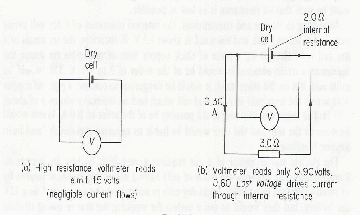The emf of a cell may be measure accurately by connecting it directly to a high resistance voltmeter. (below right). Let us suppose that a voltmeter connected to the terminals battery of internal resistance![]() gives a reading of gives a reading of
gives a reading of gives a reading of![]() This is then the emf.
This is then the emf.

A![]() resistance is now connected to the terminals of the cell. The voltmeter reading will now drop to 0.9V. The cell appears to have lost
resistance is now connected to the terminals of the cell. The voltmeter reading will now drop to 0.9V. The cell appears to have lost![]()
The current flowing in the circuit is given by![]()
where![]() and
and![]()
The voltage needed to drive this current of 0.3A through the external![]() resistor is given by
resistor is given by![]() which is the voltmeter reading.
which is the voltmeter reading.
The voltmeter is connected to the cell terminals but if it were connected to the terminals of the resistor instead the voltmeter reading would not change. It is important to realise the voltmeter reads the voltage across the external circuit and not the voltage across the batter. In the diagram above left, the external circuit is the voltmeter.
The voltage required to drive the current of 0.3A through the cell of resistance![]() is
is ![]() which is equal to the 'lost volts' of the cell.
which is equal to the 'lost volts' of the cell.
The terminal voltage is always less than the emf when the cell is connected to a circuit. The terminal voltage cannot be read from a voltmeter, and can only be obtained by subtracting the voltmeter reading from the emf.
In fact the voltmeter reading on the above left is also only an approximation to the emf of the cell. Even a very high resistance voltmeter must take some current, and so a small part of the emf of the cell will be lost in driving this current through the cell. The higher the resistance of the voltmeter, the smaller are the lost volts. For very accurate measurement of emf, a potentiometer is used.
